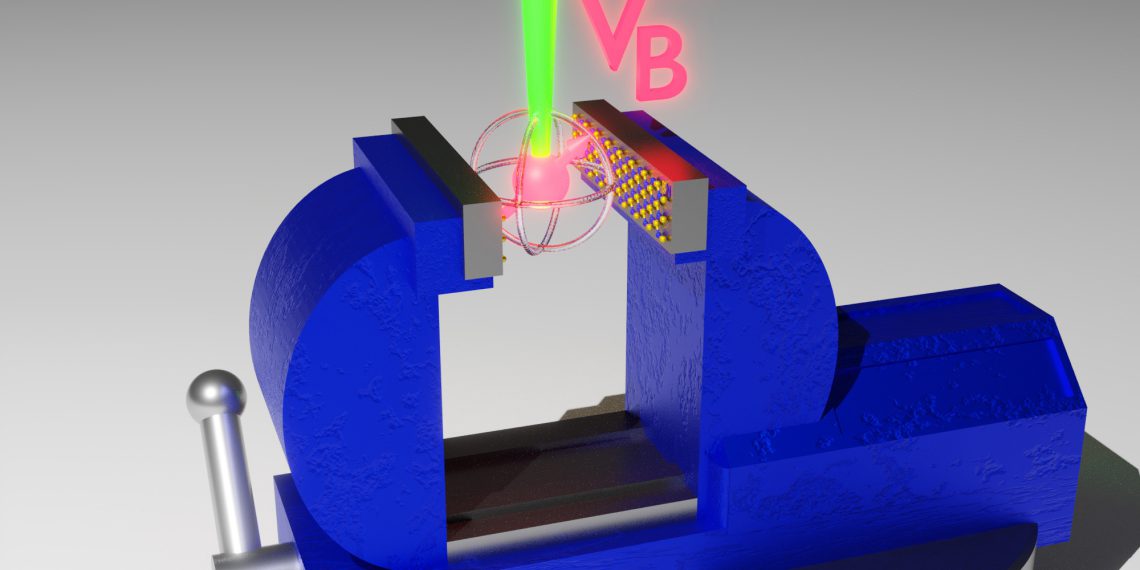A research team in Nature Communications presents a novel atomic sensor made of boron nitride. It is based on a qubit in the crystal lattice and is superior to comparable sensors.
An artificially created spin defect (qubit) in a crystal lattice of boron nitride is suitable as a sensor that can measure various changes in its immediate environment. The defect is a boron defect located in a two-dimensional layer of hexagonal boron nitride and has angular momentum (spin).
The defect is very sensitive to its atomic environment, for example, to the distances to other atoms or atomic layers.
“As a result, it can be used to measure magnetic fields, temperature and even pressure locally,” says Professor Vladimir Dyakonov, head of the Department of Experimental Physics VI at Julius Maximilians University (JMU) Würzburg. Measurements are made purely optically with a laser — so the sensor does not require any electrical contact.
“By cleverly switching microwaves of different frequencies on and off, the spin defect can be manipulated so that different external influences such as temperature, pressure and magnetic field can be derived.”
- Andreas Gottscholl, physics doctoral student at JMU
What distinguishes the novel sensor
Atomic sensors based on spin defects already exist: they are made of diamond or silicon carbide and are suitable for local measurements of temperature and magnetic field. “Our boron nitride sensor additionally responds to external pressure changes and exceeds the sensitivity of previous systems, especially at low temperatures,” Gottscholl said.
“Another new feature of our spin defect is that it lies in a two-dimensional crystal lattice. Compared to the established three-dimensional systems made of diamond or silicon carbide, this brings completely new application possibilities,” explains the Würzburg physicist.
For example, boron nitride is currently considered the standard material for encapsulating novel 2D devices such as nanometer-sized transistors. “With our work, we have provided evidence that we can artificially embed atomic sensors in the frequently used material boron nitride. This should make it possible to directly measure influences such as temperature, pressure and magnetic field on various components.”
What research steps lie ahead
So far, the researchers have demonstrated how the sensor works on a large ensemble of several million spin defects. Next, they want to show how individual spin defects function as sensors. If they succeed, it could conceivably be used on the nanometer scale.
“Particularly interesting is the idea of using boron nitride layers of only one atomic layer, so that the sensor is located directly on the surface of the components under investigation,” says Professor Dyakonov. This would allow direct interaction with the immediate environment.
Where the sensor could be used
Applications in materials research, device development or biology could be interesting, in order to gain new insights in these fields. In addition to other possible applications in science, it is also conceivable in the long term that the sensor could be used as a commercial sensor — this could revolutionize medical imaging procedures, as the sensor could, for example, map local temperatures as image contrasts.
Collaborations and sponsors
In addition to the team from JMU Physics, Dr. Mehran Kianinia and Professor Igor Aharonovich from the University of Technology Sydney (Australia) as well as Professor Carlo Bradac from Trent University (Canada) are significantly involved in the publication in Nature Communications.
Financial support for the work was provided by the Würzburg-Dresden Cluster of Excellence on Complexity and Topology in Quantum Matter ct.qmat, the Alexander von Humboldt Foundation, the Australian Research Council and the Asian Office of Aerospace Research and Development. JMU supported the publication from its open access publication fund.

















